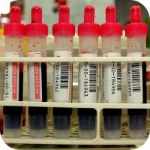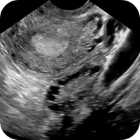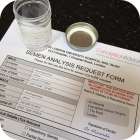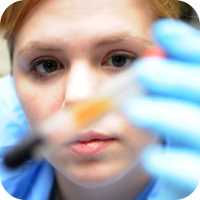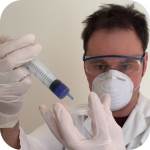What is a Hysterosalpingogram?
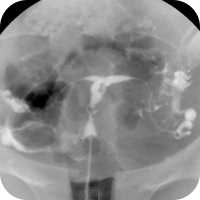
A hysterosalpingogram is an x-ray examination used to look for problems with the uterus (the womb) and the fallopian tubes (the tubes that connect the ovaries to the uterus). You will often see hysterosalpingogram abbreviated to just ‘HSG test’. It is one of the fertility tests your doctor will send you for if you have been trying to get pregnant for a while without success. You may also be sent for a HSG test to investigate the potential cause of repeat miscarriages.
The HSG test is done as an outpatient procedure and takes about 10 to 15 minutes to perform. It involves filling your uterus with a fluid that shows up on x-ray and then using a fluoroscope (a real time x-ray imager) to look at your reproductive organs.
The main reason this test is performed is to see if a fallopian tube is blocked. These tubes connect the ovaries to the uterus and you have one tube for each ovary (a total of two). It is down these tubes that the eggs travel to the uterus and where the sperm meets the egg and fertilises it. A fallopian tube blockage could prevent eggs travelling down them or sperm travelling up them.
The test can also identify any uterine fibroids, polyps, or congenital and physical abnormalities. These could distort the shape of the uterus and prevent embryo implantation into the uterus wall. However, it is more common for a pelvic ultrasound to be used to identify these problems.
Hysterosalpingogram is pronounced Hiss-ter-row-sal-ping-go-gram. A bit of a mouthful, but impressive if you can master it.
HSG Test Preparation
The HSG test is done within the first 10 days of the start of your cycle (with day 1 being the first day of your period). You are not allowed to have sex during this time. This is to make sure you aren’t pregnant, as x-ray exposure could be harmful to an embryo. You must also have finished bleeding, as this can cause misleading results in the test if you have not. Because of this, you must pay close attention to your cycle and call up the hospital or clinic within the time frame stated on the referral letter.
As there is a slim chance of an infection resulting from the HSG test, you may be asked to take a course of antibiotics. You will need to start this just before your test and continue for about a week. Always complete a course of antibiotics as this will help to prevent bugs from becoming immune to them.
When you arrive at the hospital or clinic for the HSG test, you are likely to be asked to take a pregnancy test. This is just to make absolutely certain you are not pregnant. Because of this, I would recommend that you don’t immediately go to the toilet upon arriving. This way, you’ll have enough urine in your bladder for the pregnancy test. On the off chance you don’t have to take a pregnancy test, you can always ask to use the toilet before the HSG test starts.
Wear clothes that are comfortable and you can easily take off and put back on again. This is because you will need to remove all your clothes for the HSG test and you may experience some discomfort after the test. Also leave any jewellery at home, or be prepared to take it off, as metal can interfere with the x-rays used in the test.
During the test they will fill your uterus with x-ray reflective fluid. While you will be allowed to empty this out of yourself after the test, from personal experience I can tell you that it will take more than one trip to the loo for it to completely go. Because of this, take some thick sanitary towels with you in case of leakage during the rest of the day.
Not all hospitals and clinics will have the same procedures. For example: some may ask you to attend with a full bladder. It is best to follow these local procedures. So if you are given a preparation leaflet for the HSG test when you are referred, make sure you read it thoroughly as there may be variations on the preparation described above.
The HSG Procedure
When you arrive for your HSG test, you will see a radiographer (a specialist in taking images of inside the body and diagnosing injury or disease). They will ask you the following questions before the test:
- If there is any chance that you could be pregnant. This is because the HSG test will use x-rays and they want to make absolutely certain that the x-rays used do not hurt your pregnancy. Most hospitals and clinics will also ask you to take a pregnancy test there and then to confirm you aren’t pregnant
- If you have, or have recently had, any illnesses. This is because certain conditions, like poor kidney function, can be made worse by the test. While other conditions, like pelvic inflammatory disease (PID) or a sexually transmitted disease, can cause post-test infections
- If you are taking any medication. Certain medications, such as metformin, may react with the fluid used in the test
- If you suffer from any allergies. This is because the x-ray fluid that they fill your uterus with contains iodine, to which some people are sensitive. Some doctors believe that if you have a shellfish allergy you may be sensitive to iodine, so be prepared to be asked if you are allergic to seafood
- Finally, your radiographer may ask you to sign a consent form that says you understand the risks of the HSG and agree to proceed
You will then be asked to take all your clothes off behind a privacy screen and to put on a hospital gown. You may also be given a painkiller to take at this stage. This is to make you more comfortable during the test and help you relax so as not to cramp up during the test.
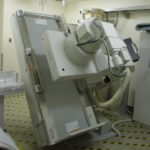
When you return from having removed your clothes, you will be asked to lay on an x-ray imaging table, legs akimbo. Above the table is an x-ray imager called a fluoroscope, which takes real time video images of your insides. The radiologist performing the HSG test will then insert a speculum into your vagina and clean the cervix with an antiseptic solution to prevent infection.
They will then insert into your cervix opening a soft funnel like device called a catheter. This is connected to a tube and it is through this device that the radiologist will fill your uterus with the liquid containing iodine that can be seen by x-rays (also referred to as radiographic contrast dye). As the fluid is being injected into the uterus, you may experience some cramping, similar to period pains.
While your uterus is being filled with liquid, the radiologist will be watching the fluoroscope image (which will be similar to the one at the top of this page and can be enlarged by clicking here). The fluid shows up in white on the image and you may be able to make out it filling your uterus, travelling along your fallopian tubes and spilling into your pelvic cavity (which is a good sign as it shows the fallopian tubes are open). Sometimes the radiographer will ask you to change position so they can view your insides from another angle.
Don’t worry if you can’t make out what the image is showing, even experts have difficulty interpreting these images from time to time. The radiologist is also unlikely to tell you what they are seeing during the HSG test. The test results will be sent to your doctor who will discuss them with you.
The HSG test is usually completed in 10-15 minutes, after which the catheter is removed and you will be allowed to put your clothes back on and go to the toilet. Though you may want to wait a couple of minutes before you get up from the table as some people feel faint immediately afterwards and it will also give the cramping time to stop.
Completely emptying your uterus of the x-ray fluid may be difficult, so pack a thick sanitary towel or two in your bag in case of leakage. You can resume normal activities after the test, but may be asked to not have sex for a few days after to ensure you don’t pick up an infection.
HSG Test Results
The best HSG test results are where they don’t find anything wrong with you. However, below are the most common problems found:
Blocked Fallopian Tubes
Your fallopian tubes are what connect your ovaries to your uterus. When your ovary releases an egg, it travels down the fallopian tube to your uterus. Sperm also travel up the fallopian tubes and fertilise your egg on its way down to your uterus. A blockage in one of these tubes (you have two; one for each ovary) can prevent the egg from getting to your uterus and the sperm from travelling up it to fertilise the egg. There are several reasons fallopian tubes can become blocked and these include:
- Endometriosis (uterus lining tissue where it shouldn’t be)
- Inflammation from an infection (the most common infections are pelvic inflammatory disease or a sexually transmitted disease)
- Scarring resulting from an infection or surgery
- A kink in the tube, where it has been pushed or pulled out of shape
- Congenital abnormality (birth defect), where the tube has not developed properly
Uterine Polyps
Polyps are abnormal growths of tissue that can be found growing in many parts of the body. When found in the uterus, they can prevent pregnancy by making it difficult for the embryo to implant on the wall of the uterus.
Fibroids
Fibroids are muscular growths that develop in the uterus and like polyps, they can make it difficult for the embryo to implant on the wall of the uterus. However, fibroids can grow to be bigger than polyps and very large fibroids can prevent pregnancies coming to full term because they take up the room in the uterus needed for the pregnancy to grow.
Congenital Abnormalities
Also known as birth defects. An abnormally shaped uterus can make it difficult for the embryo to implant or not provide enough room for the foetus to grow. Examples conditions are the bicornuate uterus (heart shaped uterus) or the uterine septum, where a thin membrane divides the uterus.
HSG Side Effects
The HSG test is considered to be a safe procedure, with a less than 1% chance of an adverse side effect occurring. However, on very rare occasions, the following complications can occur as a HSG side effect:
Infection
An infection is the most common HSG side effect. This is more likely to happen if the woman has previous had pelvic inflammatory disease or does not complete the course of antibiotics given for the HSG test. If you experience abdominal pain or a fever 1 to 2 days after having the HSG test, contact your doctor immediately.
Iodine Allergy Type Reaction
A very small number of individuals have a reaction to iodine. This HSG side effect is usually nothing more than a rash or itchiness, however in a very small number of cases the reaction can be severe. If you experience swelling, itching, or a rash after taking the HSG test, contact your doctor immediately.
Spotting
Light blood spotting may occur for up to two days after having an HSG test. However, if you experience heavy bleeding or the spotting continues for three or more days, contact your doctor.
Radiation Exposure
You will be exposed to a small amount of x-ray radiation during the test and any exposure to radiation comes with a risk. However, the radiation levels used in the HSG test are very low and if the benefits of the test did not greatly outweigh the risk of radiation exposure, they would not be performing the test on the routine basis that they currently do. There is a greater risk to your unborn if you are pregnant, which is why you will not be allowed to take the HSG test if there is any possibility that you are pregnant. However, if you become pregnant after the test, there is no evidence that the earlier radiation exposure will harm your pregnancy. If you have any concerns with radiation exposure, discuss them with the radiologist before you take the test.
HSG Test Pain
I have often been asked does a hysterosalpingogram hurt and from personal experience, I can tell you yes it does a little. But it’s not too bad.
You will experience some discomfort during the set up. However, the worse HSG test pain I experienced was from cramping (not unlike menstrual cramps) when the x-ray fluid was injected into me. This was fleeting and not enough for me to ask the radiologist to stop performing the test.
Everyone is different however. So the amount of HSG test pain you experience (if you experience any at all), will vary from my experience. Whatever happens, don’t let it put you off taking the test. There are far worse pains (like going into labour and giving birth for example) and the benefits far outweigh the small amount of HSG test pain you may experience.
HOWEVER, should you experience pain 1 to 3 days after the HSG test, immediately contact your doctor. This is not normal and could be a symptom of an infection.
Pregnancy After HSG Test
Some doctors claim that an HSG test increases the chances of a woman becoming pregnant. There are some studies that support this, showing a slightly increased chance of pregnancy after a HSG test. It is speculated that this is because the x-ray fluid opens the fallopian tubes and clears out debris blocking the tubes. However, these studies only show a very slight increased chance in pregnancy after a HSG test and that this enhanced fertility only lasts for 3 months after the test. Because of the low success rates, most doctors will only perform the test for diagnostic purposes.
If a clinic wants to charge you money for a HSG purely on the basis that it will improve your chances of getting pregnant and not for diagnostic purposes, ask them the following questions:
- What specific condition do I have that this procedure will cure?
- Where is the scientific evidence this will work?
- What success rates are there for couples getting pregnant as a direct result of this procedure in my specific situation?
- How long will any increased fertility last?
If the clinic can answer these questions to your satisfaction, then you can consider going ahead with it. If they can’t answer the questions in a way that you are happy with, then consider not taking the HSG.
Next Steps After A HSG Test
The next steps depend very much on whether they find anything wrong with you or not during the HSG test. If there is a problem, your doctor may suggest a laparoscopy (a keyhole surgical procedure) to correct any problem, or they may suggest IVF treatment to circumvent the problem. They may suggest something else, but it will depend on what is found.
If there is no problem, you may be asked to take other fertility tests, or you may be given a diagnosis of Unexplained Infertility.
h2>Links to Popular Related Pages

